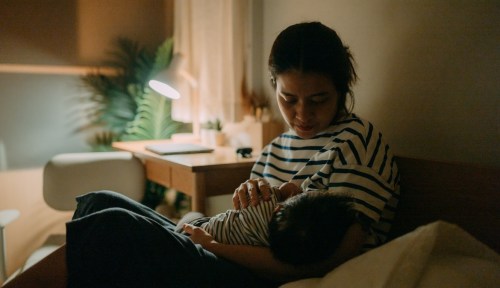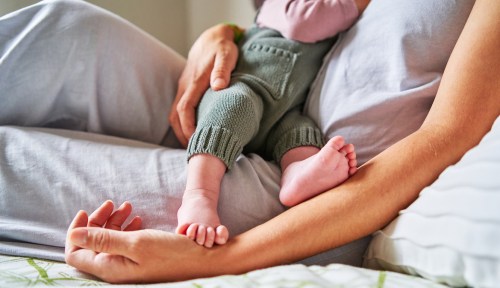Our editors independently select these products. Making a purchase through our links may earn Well+Good a commission
Get ready to start peeing a little when you sneeze. This is a common refrain many people start hearing when they get pregnant or give birth. In fact, you’ve probably heard your mother, grandmother, aunts, or friends laugh off (or cringe at) a story about when they’ve “leaked.”
Experts in This Article
double board-certified OB/GYN and urogynecologist in Los Angeles, California
doctor of physical therapy, owner of Femina Physical Therapy, and author of Sex Without Pain
urogynecologist, professor of urology, and vice chair of research at UC San Diego department urology
urogynecologist, associate professor of urology, and OB/GYN at Cedars-Sinai Hospital
urogynecologist and co-author of A Women’s Guide to Her Pelvic Floor: What the F*@# Is Going on Down There?
Even doctors say leaking a little pee every now and then—from seemingly benign activities like laughing or jumping up and down—is totally normal. If this happens to so many of us, why are we still embarrassed when we talk about it? And more importantly, why don’t we seem to take it seriously?
Urinary incontinence (or the inability to completely control your bladder) is a topic many of us shy away from—whether we’ve had a baby or not. But behind medical communities telling us it’s “normal” and “just part of life” are the women who manage (and even struggle) with it in day-to-day life.
One of those women is Jennifer Souiade—a mom of three—who says urinary incontinence was a huge part of her postpartum experience.
“Even after my daughter’s first birthday, I couldn’t jump on the trampoline without feeling like my uterus would fall out, while my pee actually did,” she says. “And that was after six months of pelvic floor therapy.”
Souiade’s problems with incontinence began after the birth of her first child, which she says was a traumatic experience for her body. “[My daughter] was born like ‘The Thinker’ statue, with her hand on her chin, tearing my vaginal wall along the way, enough to need internal stitches to repair me afterward,” she says.
Despite getting the standard postpartum care in France (where she lived at the time), which included pelvic floor therapy, she still dealt with bladder leaks that affected her daily life. “It was mentally and physically challenging,” she says. “I’d lost the mind-to-muscle connection [between my bladder and brain] and couldn’t figure out how to flex my pelvic floor.” This can not only lead to potentially embarrassing leaking incidents, but also to other side effects of pelvic floor dysfunction, like pain during sex or peeing during exercise.
With the help of her health care team, Souiade was able to fully address her incontinence issues and regain control of her pelvic floor muscles, “but I still avoid trampolines if I have a full bladder,” she says, just in case.
Souiade is just one of many who deal with urinary incontinence on a daily basis—no matter their age. It’s often seen as an embarrassing or “taboo” topic, leaving lots of us in the dark about what really causes it and how to regain control of our bladders and pelvic floors. Women may feel hesitant to bring it up to their doctors for fear of being gaslit or told that it’s “normal.”
Here, we take a deep dive into why urinary incontinence is still so taboo and how we can start serious conversations about bladder leaks so we can end the embarrassment (and associated health effects) once and for all.
How prevalent is urinary incontinence in women?
From the “oops” moment after you sneeze, to that sudden “can’t hold it anymore” urge to pee, urinary incontinence can happen for many reasons, and it’s incredibly common—affecting millions of women at all phases of life. It’s not just a product of pregnancy; it can happen to athletes like gymnasts and track runners, those who have health conditions that affect their pelvic floor (like diabetes or multiple sclerosis), people who’ve had hysterectomies, and more.
About 54 percent of women ages 20 and older will experience bladder leakage at some point in their lives, per a June 2021 study in the Journal of Urology1. Other April 2022 research in Female Pelvic Medicine and Reconstructive Surgery2 found that number could be even higher, with estimates reaching over 60 percent.
Is urinary incontinence a normal part of aging?
While it’s true that our bladders can get weaker as we age, leakage is not an inevitable part of aging. In other words, losing full control of your bladder is not always due to simply getting older. According to Victoria Scott, MD, urogynecologist and co-author of A Woman’s Guide to Her Pelvic Floor: What the F*@# Is Going on Down There?, other causes of urinary incontinence can be:
- Pregnancy
- Childbirth
- Menopause
- Having overweight
- Prior pelvic surgery
- Medications
- Family history of incontinence
And as we mentioned before, even young, active people can get bladder leaks. Female athletes that participate in high-impact sports like running and gymnastics are three times more likely to experience urinary incontinence than non-athletes, per a December 2020 review in Sports Medicine3. Rough landings after jumps can put pressure on the pelvic floor. And it just goes to show: You can be in “peak health” and still deal with this issue.
“Urinary incontinence is not just an ‘old lady’ issue,” says Heather Jeffcoat, DPT, a physical therapist and owner of Femina Physical Therapy. “Young athletes have high rates of urinary incontinence, as well as bowel (fecal) incontinence.”
Okay, if it’s common, then why is it so taboo?
In general, societal taboos around bodily functions, fear of embarrassment, and the outdated notion that bladder leaks are just a “normal” part of being a woman all contribute to stigma.
But here’s the problem: Staying silent doesn’t make the issue go away. In fact, it can make things worse, according to Karyn Eilber, MD, urogynecologist and co-author with Dr. Scott. Women might avoid social activities, miss out on things they enjoy, and even isolate or have depression and anxiety—all because they’re afraid of what might happen in public without supplies like spare underwear, pads, or a change of clothes.
This often applies to other women’s health concerns— like bleeding in public due to menstruation. Women may feel embarrassed or less equipped if it’s not openly talked about or perceived as an “embarrassing” issue.
The lack of open conversation about women’s health issues in general also fuels misinformation and perpetuates the idea that it’s something to be ashamed of or kept hidden. Consequently, many women are unaware of the availability of effective treatments or where to turn for help. As Dr. Jeffcoat puts it, “Our society doesn’t want to talk about any women’s issues, much less [what happens] ‘down there.'”
Other reasons why urinary incontinence continues to be a taboo topic include the following:
- Societal expectations and norms: Women may feel pressure to appear perfect and in control, and admitting to an issue like urinary incontinence can be seen as a sign of weakness or failure to meet those unrealistic expectations. Society’s discomfort with natural bodily functions, perceiving them as “gross” (e.g., tampon commercials still use blue liquid for demonstration!) combined with the expectation to “bounce back” quickly after childbirth makes it even harder to openly talk about post-birth issues, including urinary incontinence.
- Fear (especially fear of aging): “Anything embarrassing can become a taboo topic, but incontinence is even more taboo because it’s often associated with being old,” says Dr. Eilber. Society also tends to fear aging, or pressure women into remaining as youthful as possible, which could further lead to fear of incontinence issues.
- Limited education and awareness: This fear can also lead to a lack of knowledge, as we’ve mentioned. Women are less inclined to ask their doctors about it, and doctors are then less inclined to offer up treatment options, solutions, and reassurance that helps de-stigmatize the issue. “The message that should be amplified is that urinary incontinence is common but definitely not normal,” says Dr. Jeffcoat.
- Systemic barriers in health care: In some countries, like France where Souiade lives, getting postpartum pelvic floor therapy is standard practice. This helps women re-stabilize their pelvic floor after giving birth, to help strengthen the muscles that support their back, help them have regular bowel movements, and yes, keep control of their bladder. But this therapy is not always recommended or available right away in the U.S., or women are told to just “wait and see” if symptoms improve. The lack of proactive care (especially postpartum care), combined with systemic issues of how women’s health care is addressed (or ignored), can leave women feeling unsupported and uninformed, according to a research article in Harvard Public Health.
“When doctors normalize it, women aren’t taking the next steps to heal,” Dr. Jeffcoat says.
How we can start talking about urinary incontinence in women
The first step to breaking the taboo is acknowledging that many people go through this issue. Having open and honest conversations will also help normalize urine leaks—no matter the phase of life you’re in—and encourage women to treat and strengthen their pelvic floors and bladders, for a happier, healthier life.
Here are some things you can do:
1. Educate yourself
As with most things, knowledge is power—especially when it comes to your health. Start paying attention to when and why leaks happen. Do they happen after sneezing, coughing, laughing, or lifting something heavy? Or maybe you feel a sudden, intense urge to pee that’s hard to ignore?
Understanding the specific types of incontinence can guide you towards the right treatment. “There are two main types of urinary incontinence,” says Jennifer Anger, MD, urogynecologist, professor of urology, and vice chair of research at UC San Diego department of urology.
“Stress urinary incontinence is leakage with cough or sneeze and is common after vaginal delivery. Urgency urinary incontinence is leakage with an urge to get to the toilet. This is largely age-related,” says Dr. Anger, noting that about 40 percent of women have both types of incontinence.
2. Be your own advocate
If the inability to control your bladder is affecting your quality of life, and you bring it up to your doctor, don’t settle for a “wait and see what happens” approach. Your bladder health matters, and finding a health care provider who knows this can make all the difference.
“Be specific about your symptoms and focus on how it impacts your quality of life: Do you skip social outings? Are you having a hard time keeping up with your kids? Do you avoid the gym or wear pads/diapers every day that irritate your skin?,” says Aldene Zeno, MD, FACOG, a double board-certified OB/GYN and urogynecologist in Los Angeles, California.
Dr. Anger echoes this, and says it’s important to be vocal about your concerns. “Because your doctor may want to spend more time discussing more serious health issues (especially postpartum), they may not have enough time to talk about urinary incontinence at visits. Be sure to keep bringing it up and emphasize how much it’s impacting your quality of life.”
3. Share with people you can trust
Remember, you are not alone in this. Talking about bladder leakage with friends or family you trust can be a good source of support and comfort. They can share tips they’ve learned if they’ve dealt with it before, or accompany you to doctor’s visits—and postpartum check ups—to be a pillar of support.
“It’s important to acknowledge that urinary incontinence is embarrassing to many women, and it has profound effects on their relationships,” says Dr. Zeno. “It impacts intimacy, and many feel self-conscious even talking to their significant other about it. If you have the opportunity to discuss it with a trusted friend, you may be surprised to learn you’re not alone.”
4. Find an online support group
Finding an online support group can provide a safe and anonymous space to discuss your experiences with others who can relate. The Simon Foundation for Continence and National Association for Continence offer online forums and resources. Or you can find Facebook groups dedicated to urinary incontinence, where you can connect with women from around the world and share advice, support, and resources.
The bottom line
Whether you’re an athlete dealing with leaks during training, a postpartum parent with incontinence, or an older adult adjusting to menopause and changing pelvic floor health, urinary incontinence does not have to just be accepted as the “norm.” Talking with your doctor, trying things like pelvic floor therapy or bladder training, and opening up to your friends and family about your struggles (or even feelings of shame and embarrassment!) around incontinence will help de-stigmatize the issue—and health issues that affect women overall.
That way, like Souiade, you can go ahead and play with your kids, jump on that trampoline, or laugh at that joke without a thought except “this is fun.”
Lee, Una J., et al. “Prevalence of Urinary Incontinence among a Nationally Representative Sample of Women, 2005–2016: Findings from the Urologic Diseases in America Project.” 2021. Journal of Urology, vol. 205, no. 6, WoltersKluwer, June 2021, pp. 1718–1724, doi:10.1097/JU.0000000000001634.
↩︎Patel, Ushma J et al. “Updated Prevalence of Urinary Incontinence in Women: 2015-2018 National Population-Based Survey Data.” Female pelvic medicine & reconstructive surgery vol. 28,4 (2022): 181-187. doi:10.1097/SPV.0000000000001127
↩︎Bø, Kari, and Ingrid Elisabeth Nygaard. “Is Physical Activity Good or Bad for the Female Pelvic Floor? A Narrative Review.” Sports medicine (Auckland, N.Z.) vol. 50,3 (2020): 471-484. doi:10.1007/s40279-019-01243-1
↩︎
Sign Up for Our Daily Newsletter
Get all the latest in wellness, trends, food, fitness, beauty, and more delivered right to your inbox.
Got it, you've been added to our email list.










